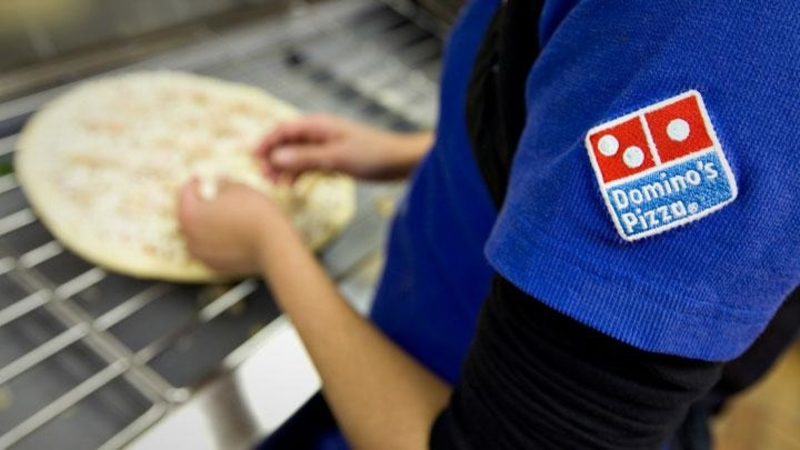Domino’s: A Breakthrough for a Failing Brand
Digital transformation is everywhere! When we think about a digitally transformed company, what are some of the obvious responses that come to mind? Amazon, Facebook, and Google? These enterprises have all, of course, transformed the digital world in every way, so who is the black horse? We probably never think of pizza firms first when we think about the best web experiences.
However, through unique modern techniques, Domino’s Pizza has re-invented its brand reputation and customer commitment. It is an example of a business which has undergone major technology-driven restructuring in a conventional market.
How Domino’s Was Doing for Roughly Half a Century
What led to the company’s growth? How did the company harness technology by providing a better experience to embed itself into the lives of its customers?
Take a look at some key points regarding Domino’s background to get a clear understanding about this brand.

The Domino’s Pizza Corporation is an American chain of restaurants selling pizza delivery franchises. Tom Monaghan and his brother James began Domino’s as a small store in the 1960s under a different name and called it Domino’s in 1967. They borrowed $900 to rent a store and used the first orders of a Volkswagen beetle as the delivery van.
Historically, they always strive for becoming the best pizza delivery company in the world. At Domino’s Pizza, values are summed up in a chant that’s sung in their stores
“Sell more pizza, have more fun!”
– Domino’s Pizza
This belief is divided into two small missions which concentrate on two main categories. The first part – “sell more pizza” – focuses on pizza, while the second one – “have more fun” – focuses on people.
Domino’s share price growth has been outperforming leading tech companies such as Google, Amazon, Facebook, Apple for the past 10 consecutive years since 2017. It was the first pizza chain to debut an online pizza tracker and a voice-ordering app, to name just a few. Gradually, Domino’s has changed their business model from a pizza-maker to a delivery and tech company.
“We are as much a tech company as we are a pizza company”
– Patrick Doyle, Former CEO at Domino
During the quarter of 2020, the Company opened 178 gross new stores and 69 net new stores, comprising 30 net new U.S. stores and 39 net new global stores.
Through the first half of 2020, Domino’s generated $240 million in net income, a 30 percent improvement over last year, amid slower growth in international markets. Domino’s owners have been well compensated. The stock of the pizza giant rose by 24 percent in 2020 during the first week of August.
Domino’s Pizza ranks 8th on the ranking of the world’s largest fast-food franchises ranked by sales in 2020 and was the leading pizza restaurant chain in the United States in 2019.
3 Standard Requirements for a Final Product
Before ever reaching the evaluation point, new product releases at Domino’s go through a range of filters. The filters fell under three overarching requirements, Richard Allison – a Domino’s chief executive officer since July 2018 – said.
#1 – Menu Item Has to Fit into the Context of the Brand
In the context of “oven-baked pizza, oven-baked goodness,” every new item released has to fit with it.
“Despite the products we have launched over time, 7 out of every 8 orders still go out with at least one pizza,” Allison said. “So a lot of what we launch — have launched over time — is really complementary to that pizza experience. So staying within that Domino’s brand and pizza halo is important.”
#2- Menu Item Needs to Contribute Incremental Profitability at the Store Level
Allison said Domino’s reviews hundreds of things a year, but if the organization thinks like the product would cannibalize the selling of pizza or other goods on the menu and not have additional revenue, so it would not be released.
“We don’t care what the item mix would be as a percentage of sales,” he said. “All that matters is dollar sales and dollar profit increases for the franchisee.”
#3 – Operations are the Overarching Criteria
If it is not possible to implement a new menu item without introducing considerable operating complexity to stores, it would not be implemented. Allison said the reliability of the manufacturing process and distribution model of Domino were too critical for the company’s performance to avoid major organizational changes undermining it.
How E-Commerce Transition Took on the Domino’s Failing Brand

The Need for Transformation
Multiple sources provided the need for Domino’s digital transformation. On the business side, the stock price of Domino’s Pizza reached an all-time low in 2008 and it was outperformed by its main competitor, Pizza Hut, in the pizza distribution market. On the consumer hand, Domino’s pizzas at the time were not well regarded, so it was important to enhance the pizza itself.
Moreover, the credibility of Domino’s brand stooped very bad. The pizza delivery chain was under siege because of its poor quality and service. Basically, it was little more than the staple meal of college students. The reviewers called their pizza dry, rubbery, cardboard-like and tomato sauce like ketchup.
Domino’s embarked on a journey to strengthen its image under Doyle’s leadership, to reach flawless delivery.
3 Key Initiatives of Domino’s Digital Transformation
Domino’s wanted to follow an ambition to be a visionary in terms of its digital capability in reaction to these consumer and industry shifts. The company started investing aggressively in emerging technology as well as marketing and software engineering personnel to facilitate a digital revolution and propel the company ahead.
The goal: to make transactions as frictionless as possible, regardless of they are – even if that happens to be a beach. “In that instant when our customer is thinking, ‘What should I get for dinner?’ an easy ordering experience can make a world of difference,” says Dennis Maloney, Domino’s chief digital officer.
#1 – Creating a Digital Platform for Consumers
Domino’s began to broad-based its availability as the number of digital platforms proliferated. In May 2015, it introduced emoji ordering, which lets customers summon dinner by tweeting a pizza icon. In May 2015, it launched emoji ordering which helps clients to call dinner by tweeting a pizza symbol. Less than a year later, it became the first fast food chain to announce an application for Amazon Echo that allows users to order via voice command.
Customers are now able to order via Apple TV, Google Home, Amazon Echo, Ford Sync, SMS, Samsung Smart TVs, smartwatches, in-app voice assistants, and other new channels, as well as via Tweets, Slack, and Facebook. Their solution’s platform diversity has helped Domino’s to recruit top talent to work on product growth.
The company’s latest breakthrough is the no-click ordering. By simply clicking a button on their Apple Watch, Domino’s Quick Order feature helps consumers to buy a pizza. And when consumers open the app, Domino’s Zero Click app automatically orders a pre-saved pizza option, with no clicks needed. The app has a 10-second countdown window to cancel the order in the event that users have accidentally opened the app.
Besides the omnichannel approach, the company also encouraged consumers to express their views on social media, opened the floodgates, and compensated the most common views and proposed ideas in the form of cash.
#2 – Digitizing Operations

Since at least 2008, Domino’s introduced a pizza tracker that provided a live status update of their pizza to their clients, always letting them know how close the pizza was for delivery.
Domino’s Pizza Tracker capability enables it to monitor an order from the oven to the home of the customer effortlessly and customers also have complete transparency about when the process starts.
#3 – Creating a Digital Enterprise Platform for Franchisees
Finally, to lower prices and to be able to deliver an attractive option to its end consumers, Domino’s has invested substantially in improving operating efficiencies. To strengthen coordination between its franchisees and the corporate office and to reduce the amount of order errors and improve training hours, the organization launched PULSE, an automated POS (Point of Sale) system.
Additionally, Domino’s has a vertically integrated dough processing and supply chain structure that increases product efficiency and consistency, helps Domino’s to exploit economies of scale and encourages store managers to further concentrate on store management and customer service.
Delivery Service Might Be the Most Important Component
Compared to its counterparts, there is another important distinction in how Domino’s delivers, one that helps it to optimize profits. Although several Pizza Hut and Papa John’s stores directly sell their pizzas to customers, in order to attract more customers, some retailers have now teamed up with third-party delivery providers.
In 2019, Papa John’s worked with DoorDash, while Pizza Hut has a comparable partnership with Grubhub. Especially dependent on third-party operators are local pizza chains. Domino’s, on the other hand, depends only on its own distribution infrastructure.
Third-party delivery providers allow local pizza places, but it comes at an expense, to scale up their delivery capacity.
Although Domino’s franchisees pay $0.25 for internet deal, small companies are paid $2 to $3 for a comparable purchase by third-party operators, according to financial services company BTIG.
How Technology Raised Sale for Domino’s During COVID-19 Pandemic
Through digital-ordering platforms, it is much easier for individuals to send food requests without having to set foot inside a physical shop. Without needing to get out of their vehicles, they will even collect pizzas. The “carside delivery service” of the company requires a client to use an app to indicate they have arrived outside a supermarket. An employee will then come out and put the food order directly into the customer’s car trunk.
During the Covid-19 crisis, contactless systems such as this one and other wireless projects enabled Domino’s expansion.
Before-After Transformation: Was Domino’s Different?
It was reported that the chain supplies more than 1 million pizzas a day, with worldwide revenue of $10.9 billion in 2016, including those of franchisees, about twice the $5.5 billion it reported in 2008.
In 2016, Domino’s created an estimated $5.6 billion in global digital revenue, an improvement from 2015 of 19 percent. In 2016, gross worldwide sales were $10.9 billion and $9.9 billion in 2015, pointing to the immense importance of digital.
Thanks to the convenient digital service, the company’s U.S. revenues in the same store increased 16.1 percent in the second quarter of 2020 and its overall worldwide revenue rose 13.4 percent year-over-year, reaching $929 million.
Since the beginning of April, Domino’s share price, which closed at $413.54 on September 23, has risen almost 28%.
Overall, Domino’s digital approach is paying off, with over half of the distribution income, with the app and website taking in more than $2 billion in digital revenues a year. Same-store revenues jumped nearly 10% in the second quarter of 2016, a spike the firm attributes in part to its tech activities.
3 Key Ingredients Supported the Domino’s Technological Revolution

#1 – Organizational Buy-in From the Top Down was Critical
It was important that everyone at the top, from the Board of Directors to the CEO and on down, had to be on board, recognizing it would take a huge infrastructure commitment to produce a world-class e-commerce experience. Kelly and Dennis Maloney, the Chief Digital Officer, went to the Board in 2012 to outline the company’s risks.
They proposed the notion that they wanted to start thinking about themselves as an “e-commerce business that happens to sell pizza” in order to succeed. The CEO already believed in and strongly embraced this mission, and the technology strategy was financed after the Board was behind it as well.
It was crucial to establish a good culture at the organization, along with receiving support from the top down. The vision was marketed early on as a way of hiring talent. The atmosphere is one of love and enthusiasm, with very little attrition, when they continued to achieve results. Kelly emphasized how important it was for leadership team members to be united as allies during this period. Some companies struggle to set a rocky precedent for the rest of the market because of tension at the top.
#2 – Relentless Dedication to Measuring Results
Domino’s was able to employ A/B testing against any new method and method they introduced with the help of an excellent analytics team. By design, digital goods, especially those focused on ordering, supply vast amounts of data. They were able to offset costs and show worth by knowing what was affecting bottom-line outcomes and profits, both around the board and by franchise. This, in turn, allowed them to scale up the areas that were running with more budget and funding.
#3 – Mutual Relationship Between Marketing and Technology
It was important for the brand to be open on both their desire to adapt and their tremendous commitment in their digital transformation. They have developed channels such as Think Oven to sustain a two-way conversation with them, in addition to engaging extensively in telling customers about their new digital goods. It was important from the outset, according to Kelly, to foster an atmosphere where the marketing and IT departments were inclusive and strategically coordinated.
The Secret Sauce for Operation
“Our marketing and IT groups actually work together. Everyone on both of those teams is trying to achieve the same goals. We win together, we fail together,” said Dennis Maloney, Domino’s chief digital officer. “Honestly, I think that’s our secret sauce,” he said.
And that secret sauce is flavored via innovation in CX. “We are focused on delivering great experiences for our consumers, everything else doesn’t matter,” he stressed.
According to the company’s chief digital officer, innovation is about more than getting to market first. “You need the right structure for innovation,” said Dennis. “You need the right people, too. You also need executive support and a business model that can support that level of innovation.”
Moreover, “Pizza shouldn’t be creating angst with our consumers,” “It’s supposed to be a fun food,” said Mr. Dennis.
On the one hand, one of the most important mindsets is that “we needed to become comfortable with failure because if you’re moving fast, not everything is going to be perfect,” he said. “You need to get very good at trying to figure out how to test things. It’s smaller tests instead of just launching stuff to figure out what’s happening. You also have to get really good at understanding data.”
“Failure is part of winning in a customer-first digital age,” says Mr. Dennis.
The Bottom Lines
Domino’s performance illustrates that it is not just the digital natives who are able to transform their market and produce exceptional value. Perhaps the key thing to be learnt from Domino’s is that doing the basics right first is of the highest significance, given all the difficulties an organization faces in attempting to make a modern transition. It needs patience, but creating the base is important before taking on the bright new artifacts, along with getting buy-in from the whole company.
Moreover, the company should remember to listen and respond to their customers as well as their people. Innovating in areas that matter to their staff members and clients, as well as maintaining high image levels in their stores are also needed to concentrate on.









